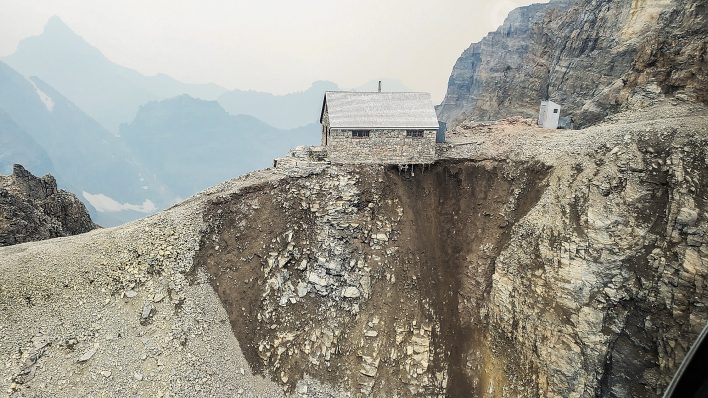All that remains of the Abbot Pass Hut in Canada’s Yoho National Park is a low-slung rock wall and a century of memories. The wind-swept cabin perched in the col between Mt. Victoria and Mt. Lefroy survived the Great Depression, World War II and the Cold War, but another global calamity—climate change—proved to be its downfall.
In 1922, Swiss mountain guides, looking to ease approaches and provide a haven for themselves and clients, built the refuge at 9,596 feet from rocks collected on Abbot Pass and timbers carted in by horses to the glacier below. Its tall, symmetrical, slender appearance resembled the chalets of their home country, and its placement—along a narrow ridge with snow-filled precipices on both sides—was aesthetically pleasing and a testament to their construction prowess.
Ensuing decades saw mountaineers of all stripes test their mettle against the classic walls cleaving the slopes above, namely the west face of Mt. Lefroy and the southeast ridge of Mt. Victoria. Recreational climbers base camped there for bucket-list objectives, and it became a stopover for the first ascensionists who dot Canada’s climbing guidebooks. “It is one of our most historical huts, you know, steeped in tradition,” says Jim Gudjonson, a climbing guide and the Alpine Club of Canada’s (ACC) vice president of facilities. “It really was one of our flagship huts in terms of the history and the location, and all of the people that have visited over the years.”

As one would expect for a century-old structure in the remote Canadian Rockies, the Abbot Pass Hut was bare bones, simply featuring a fireplace, bunks and handmade wooden furniture. The second-highest permanent habitable structure in Canada (after Kootenay National Park’s Neil Colgan Hut), it was the kind of place where a fire was welcome even in the summer, as temperatures dipped at night and residents were chilled from days spent in the snow. Anchored into ice-covered slopes, it was built to last, but in recent years, warming summer temperatures receded the glacier below, exposing the friable rock to heat and eroding the slopes from which it was hewn.
“There was a guide and some other climbers who were up at the hut, and they noticed some cracks on the foundation wall on the north aspect,” Gudjonson says. “And they had some concern that the slope below was melting quite rapidly.” That was in 2018, and the deterioration triggered a 600,000 Canadian dollar Parks Canada effort to save the hut, which Keith Haberl, communications director for the ACC, gratefully called a valiant attempt and an appreciated recognition of the cabin’s historical significance. Though the ACC oversaw day-to-day maintenance and cabin rentals, Parks Canada was ultimately responsible for major renovations due to the hut’s location in a national park.
Because the Abbot Pass Hut was a national historical site, a designation the country bestowed on it in 1992, Parks Canada pulled out all the stops in its four-year effort to salvage the hut. “It’s a place that means a lot to many people in the alpine community, and that includes the guiding community,” says Francois Masse, superintendent of the Lake Louise, Yoho and Kootenay Field Unit. “Parks is very, very cognizant of that, so that’s why we spared no effort to protect this building and try and save it.”
Geotechnical studies were conducted. Rock anchors were installed. More slope stability work was planned, but the climate had other ideas. The glaciated slope and permafrost the cabin depended on for stability continued to recede during warm summers, but the final blow came during a 1,000-year heatwave that hit western North America in 2021. Across half the continent, record-breaking temperatures that spiked into the triple digits in many places melted vinyl siding and asphalt roads, overloaded air conditioners and wreaked havoc in the mountains. Without the ice that had historically bound the slope together, erosion accelerated, proving that no amount of concrete work and rock anchors could bring stability to the structure.
Parks Canada hired Tangiers Mountain Construction to dismantle the hut using hand power tools and scatter most of the rocks back to the slopes they were drawn from. After nearly a century of alpinism history, the Tangiers crew lit the last fire as a heritage team documented the end of an impressive run for what Haberl called “a crown jewel of our hut system.”
Though the building itself is gone, its story may live on for decades to come. As part of its heritage recording, Parks Canada saved materials from the hut, and staff members are working with First Nations representatives, the ACC and others to develop a plan for memorializing it. “We are very, very keen, definitely committed, to commemorate this building and its place in the mountaineering history of Canada,” Masse says.
For now, while those talks ensue, a plaque and that partially constructed rock wall are the last vestiges of the Abbot Pass Hut, the only physical reminders of those Swiss guides who had the foresight and talent to build a refuge that survived a century of winters in the Canadian Rockies.
This essay was originally published in Issue No. 147. To read more, pick up a copy at backcountrymagazine.com/147, or subscribe to find our stories earlier when they are published in print.










Related posts: